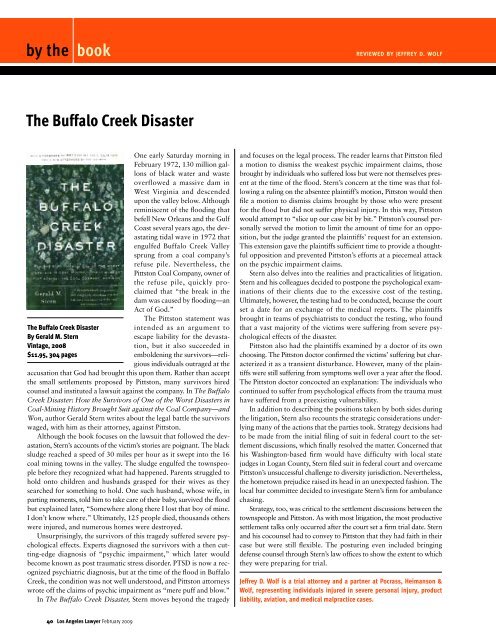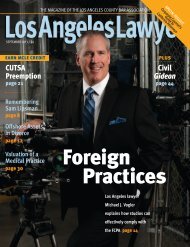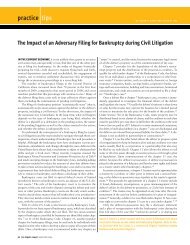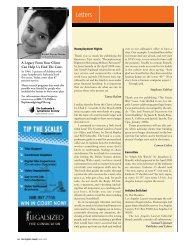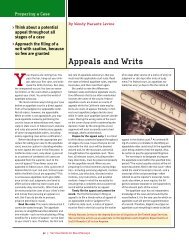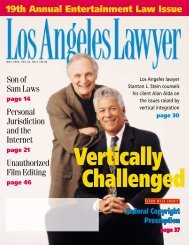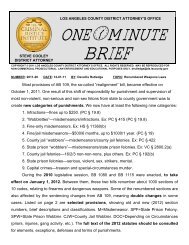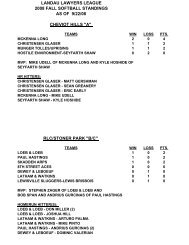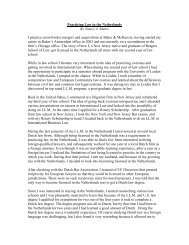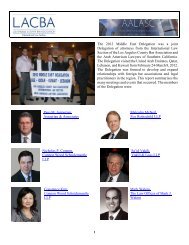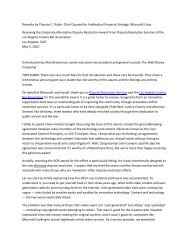The Buffalo Creek Disaster - Los Angeles County Bar Association
The Buffalo Creek Disaster - Los Angeles County Bar Association
The Buffalo Creek Disaster - Los Angeles County Bar Association
You also want an ePaper? Increase the reach of your titles
YUMPU automatically turns print PDFs into web optimized ePapers that Google loves.
y the book REVIEWED BY JEFFREY D. WOLF<br />
<strong>The</strong> <strong>Buffalo</strong> <strong>Creek</strong> <strong>Disaster</strong><br />
<strong>The</strong> <strong>Buffalo</strong> <strong>Creek</strong> <strong>Disaster</strong><br />
By Gerald M. Stern<br />
Vintage, 2008<br />
$11.95, 304 pages<br />
40 <strong>Los</strong> <strong>Angeles</strong> Lawyer February 2009<br />
One early Saturday morning in<br />
February 1972, 130 million gallons<br />
of black water and waste<br />
overflowed a massive dam in<br />
West Virginia and descended<br />
upon the valley below. Although<br />
reminiscent of the flooding that<br />
befell New Orleans and the Gulf<br />
Coast several years ago, the devastating<br />
tidal wave in 1972 that<br />
engulfed <strong>Buffalo</strong> <strong>Creek</strong> Valley<br />
sprung from a coal company’s<br />
refuse pile. Nevertheless, the<br />
Pittston Coal Company, owner of<br />
the refuse pile, quickly proclaimed<br />
that “the break in the<br />
dam was caused by flooding—an<br />
Act of God.”<br />
<strong>The</strong> Pittston statement was<br />
intended as an argument to<br />
escape liability for the devastation,<br />
but it also succeeded in<br />
emboldening the survivors—religious<br />
individuals outraged at the<br />
accusation that God had brought this upon them. Rather than accept<br />
the small settlements proposed by Pittston, many survivors hired<br />
counsel and instituted a lawsuit against the company. In <strong>The</strong> <strong>Buffalo</strong><br />
<strong>Creek</strong> <strong>Disaster</strong>: How the Survivors of One of the Worst <strong>Disaster</strong>s in<br />
Coal-Mining History Brought Suit against the Coal Company—and<br />
Won, author Gerald Stern writes about the legal battle the survivors<br />
waged, with him as their attorney, against Pittston.<br />
Although the book focuses on the lawsuit that followed the devastation,<br />
Stern’s accounts of the victim’s stories are poignant. <strong>The</strong> black<br />
sludge reached a speed of 30 miles per hour as it swept into the 16<br />
coal mining towns in the valley. <strong>The</strong> sludge engulfed the townspeople<br />
before they recognized what had happened. Parents struggled to<br />
hold onto children and husbands grasped for their wives as they<br />
searched for something to hold. One such husband, whose wife, in<br />
parting moments, told him to take care of their baby, survived the flood<br />
but explained later, “Somewhere along there I lost that boy of mine.<br />
I don’t know where.” Ultimately, 125 people died, thousands others<br />
were injured, and numerous homes were destroyed.<br />
Unsurprisingly, the survivors of this tragedy suffered severe psychological<br />
effects. Experts diagnosed the survivors with a then cutting-edge<br />
diagnosis of “psychic impairment,” which later would<br />
become known as post traumatic stress disorder. PTSD is now a recognized<br />
psychiatric diagnosis, but at the time of the flood in <strong>Buffalo</strong><br />
<strong>Creek</strong>, the condition was not well understood, and Pittston attorneys<br />
wrote off the claims of psychic impairment as “mere puff and blow.”<br />
In <strong>The</strong> <strong>Buffalo</strong> <strong>Creek</strong> <strong>Disaster</strong>, Stern moves beyond the tragedy<br />
and focuses on the legal process. <strong>The</strong> reader learns that Pittston filed<br />
a motion to dismiss the weakest psychic impairment claims, those<br />
brought by individuals who suffered loss but were not themselves present<br />
at the time of the flood. Stern’s concern at the time was that following<br />
a ruling on the absentee plaintiff’s motion, Pittston would then<br />
file a motion to dismiss claims brought by those who were present<br />
for the flood but did not suffer physical injury. In this way, Pittston<br />
would attempt to “slice up our case bit by bit.” Pittston’s counsel personally<br />
served the motion to limit the amount of time for an opposition,<br />
but the judge granted the plaintiffs’ request for an extension.<br />
This extension gave the plaintiffs sufficient time to provide a thoughtful<br />
opposition and prevented Pittston’s efforts at a piecemeal attack<br />
on the psychic impairment claims.<br />
Stern also delves into the realities and practicalities of litigation.<br />
Stern and his colleagues decided to postpone the psychological examinations<br />
of their clients due to the excessive cost of the testing.<br />
Ultimately, however, the testing had to be conducted, because the court<br />
set a date for an exchange of the medical reports. <strong>The</strong> plaintiffs<br />
brought in teams of psychiatrists to conduct the testing, who found<br />
that a vast majority of the victims were suffering from severe psychological<br />
effects of the disaster.<br />
Pittston also had the plaintiffs examined by a doctor of its own<br />
choosing. <strong>The</strong> Pittston doctor confirmed the victims’ suffering but characterized<br />
it as a transient disturbance. However, many of the plaintiffs<br />
were still suffering from symptoms well over a year after the flood.<br />
<strong>The</strong> Pittston doctor concocted an explanation: <strong>The</strong> individuals who<br />
continued to suffer from psychological effects from the trauma must<br />
have suffered from a preexisting vulnerability.<br />
In addition to describing the positions taken by both sides during<br />
the litigation, Stern also recounts the strategic considerations underlying<br />
many of the actions that the parties took. Strategy decisions had<br />
to be made from the initial filing of suit in federal court to the settlement<br />
discussions, which finally resolved the matter. Concerned that<br />
his Washington-based firm would have difficulty with local state<br />
judges in Logan <strong>County</strong>, Stern filed suit in federal court and overcame<br />
Pittston’s unsuccessful challenge to diversity jurisdiction. Nevertheless,<br />
the hometown prejudice raised its head in an unexpected fashion. <strong>The</strong><br />
local bar committee decided to investigate Stern’s firm for ambulance<br />
chasing.<br />
Strategy, too, was critical to the settlement discussions between the<br />
townspeople and Pittston. As with most litigation, the most productive<br />
settlement talks only occurred after the court set a firm trial date. Stern<br />
and his cocounsel had to convey to Pittston that they had faith in their<br />
case but were still flexible. <strong>The</strong> posturing even included bringing<br />
defense counsel through Stern’s law offices to show the extent to which<br />
they were preparing for trial.<br />
Jeffrey D. Wolf is a trial attorney and a partner at Pocrass, Heimanson &<br />
Wolf, representing individuals injured in severe personal injury, product<br />
liability, aviation, and medical malpractice cases.
Stern describes the practical hurdles he<br />
encountered during the settlement discussions.<br />
He represented numerous plaintiffs,<br />
and he knew that Pittston’s counsel would<br />
insist that he have authority to negotiate a settlement<br />
on behalf of all of his clients.<br />
Although the townspeople gave him authority<br />
to settle, ethical considerations precluded<br />
him from entering into a binding settlement<br />
on behalf of multiple plaintiffs without first<br />
telling them how much each plaintiff would<br />
receive. Stern resolved the problem by obtaining<br />
permission to conduct the discussions<br />
and provide recommendations for a split.<br />
With such close attention to detail about<br />
the legal process, it is not surprising that<br />
often the book has been required reading<br />
for law students. However, <strong>The</strong> <strong>Buffalo</strong> <strong>Creek</strong><br />
<strong>Disaster</strong> goes well beyond providing some<br />
valuable lessons about the litigation process.<br />
<strong>The</strong> book shows how our court system can<br />
be a great equalizer, placing large multimillion-dollar<br />
corporations on even footing with<br />
people who have no economic or political<br />
clout.<br />
Through the litigation and more specifically<br />
the discovery process, Pittston became<br />
answerable to the people of the town. Depositions<br />
of key Pittston personnel revealed that<br />
Pittston knew that it was exposing the people<br />
to significant risk of the flood. With the<br />
revelation of this information, Pittston faced<br />
true exposure to punitive damages and, consequently,<br />
power shifted to the townspeople.<br />
<strong>The</strong>reafter, Pittston settled the claims and<br />
finally compensated the victims for their loss.<br />
Beyond that, the settlement served as a check<br />
on Pittston, deterring it from constructing<br />
another faulty dam. <strong>The</strong> threat of this type<br />
of litigation forces large corporations like<br />
Pittston to rethink business decisions that<br />
place the public in harm’s way.<br />
Yet, even after we read <strong>The</strong> <strong>Buffalo</strong> <strong>Creek</strong><br />
<strong>Disaster</strong> and celebrate the triumph of the<br />
townspeople in the wake of the flood that<br />
destroyed their town over 35 years ago, we<br />
are faced with news of another, similar failure.<br />
In December 2008, the Tennessee Valley<br />
Authority’s Kingston Fossil Plant in Harriman,<br />
Tennessee, experienced a failure of a<br />
dike wall. <strong>The</strong> broken earthen wall released<br />
approximately 1 billion gallons of slurried ash<br />
from a coal-ash containment pond.<br />
Fortunately, no one was killed, but the spill<br />
destroyed homes and continues to pose environmental<br />
threats as the result of the release<br />
of barium, lead, manganese, and arsenic<br />
compounds. Cenospheres, which are spherical<br />
particles of silica, polluted the local lake.<br />
<strong>The</strong> Tennessee Valley Authority has reported<br />
that the cenospheres can cause watering of the<br />
eyes, sneezing, or coughing but do not pose<br />
a health threat. At least it has not yet attributed<br />
the spill to an act of God. ■<br />
Thinking<br />
of retiring?<br />
But don’t know<br />
how your clients’<br />
legal needs<br />
will be met?<br />
EXPERIENCE<br />
<br />
INTEGRITY<br />
<br />
HONESTY<br />
Westside AV-rated law firm, specializing<br />
in litigation and transactional matters—<br />
business, partnership, real estate,<br />
trademark and copyright, would like to<br />
talk to you.<br />
To discuss confidentially, please call 310.826.2627<br />
and ask for Ken Linzer or email your interest to<br />
youcanretirefromlaw@gmail.com<br />
EXPERT WITNESS — Claims Consultant<br />
OVER 45 YEARS EXPERIENCE as a claims adjuster, licensed in three states and<br />
qualified in state and federal courts. Expert in good faith/bad faith,<br />
standards and practices and standard in the industry. Specialties in<br />
property/casualty construction defect, fire/water, uninsured/underinsured<br />
motorist, warehouse and cargo claims. Failure to defend and/or indemnify.<br />
Litigation support, case review and evaluation claim consultation, coverage<br />
review and valuations. Appraisal, Arbitration and Claims Rep. at MSC & MMC.<br />
Contact Gene Evans at E. L. Evans Associates<br />
Phone (310) 559-4005 / Fax (310) 390-9669 / E-mail elevans66@yahoo.com<br />
3310 AIRPORT AVENUE, SUITE 2, SANTA MONICA, CALIFORNIA 90405<br />
<strong>Los</strong> <strong>Angeles</strong> Lawyer February 2009 41


